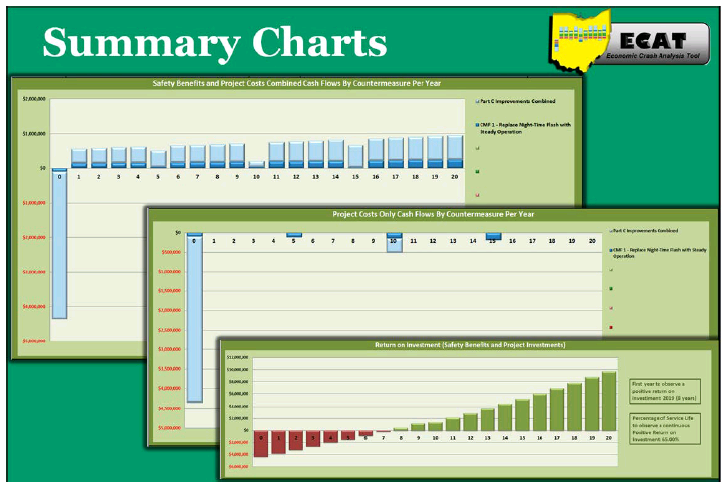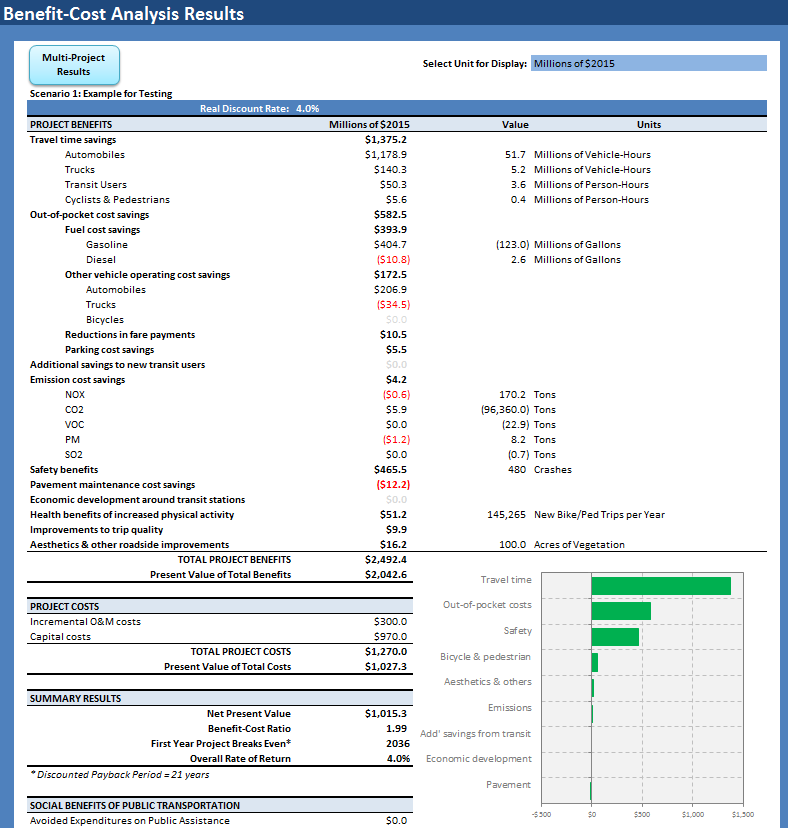Publication Year: 2017
Background
The California Department of Transportation (Caltrans) must continuously justify the economic effectiveness of their programs and expenditures. In selecting among alternative projects and programs, there is a need to quantify and compare factors such as safety performance, pavement preservation, operational performance, and environmental impacts. Benefit-cost analysis (BCA) supports these decisions by quantifying life-cycle costs and benefits, which helps to understand the potential return on investment from alternative projects and programs. While Caltrans routinely quantifies and compares project costs and benefits, there was a need to automate the calculations to improve the efficiency and consistency of analysis.
Solution
Caltrans developed the Cal-B/C tool for BCA of highway and transit projects. It is an Excel spreadsheet application structured to analyze transportation improvement projects in a corridor where there already exists a highway facility or a transit service (the base condition). The tool calculates benefits for existing and (optionally) for induced traffic, as well as for any traffic diverted from a parallel highway or transit service. It estimates benefits separately for peak and off-peak periods as well as for high occupancy vehicle (HOV) and non-HOV passenger vehicles and trucks.
Analysts can use the tool to evaluate highway projects such as general improvements, HOV and passing lanes, interchange improvements, and a bypass highway. Transit projects may include new or improved bus services, with or without an exclusive bus lane, light-rail, and passenger heavy-rail projects. Analysts can evaluate a proposed highway or transit project independently or in the presence of the competing mode, in which case the tool estimates the benefits to diverted traffic.
For costs, the analyst can enter the total life cycle investment and annual operating and rehabilitation costs. The tool considers the following categories of benefits:
- Travel time.
- Safety (both highway and transit).
- Vehicle operating costs (for highway users).
- Emissions (CO, NOx, PM10, VOC) (optional output).
The tool provides the following economic performance measures:
- Net present worth.
- Benefit-cost ratio.
- Internal rate of return.
- Payback period.
Example Application
Description and Purpose of Project
The Commercial Vehicle Information Systems and Networks (CVISN) Program seeks to expand electronic credentialing and screening of commercial vehicles to improve safety and efficiency. CVISN is intended to enhance the safety and efficiency of commercial vehicles nationwide. Benefits include lower costs for vehicle credentialing and operations and more effective safety inspections. Trucks with good safety records save time by bypassing inspection stations at highway speeds. The public benefits from the program through decreased energy consumption and noise pollution. In addition, a more effective inspection system will result in safer commercial vehicles on the road and thus fewer heavy truck accidents.
Alternatives Considered
For this study, a benefit-cost analysis was conducted separately for two CVISN components, roadside enforcement and electronic credentialing.
For roadside enforcement, the analysis included three alternatives. The first was an upgrade of inspection station computer systems, but without electronic screening. The second was an upgrade from the first scenario to electronic screening and additional station improvements. The third, treated as a sensitivity analysis, entailed the same as the second, with the added assumption that the motor carrier safety regulation violation rate will decrease by 25 percent.
For electronic credentialing, the analysis included two alternatives. The first was electronic credentialing for states not using the Vehicle Information System for Tax Apportionment (VISTA). The second was electronic credentialing for those states currently using VISTA.
Results
Table 1 shows the results of the BCA for the three roadside enforcement scenarios. The benefits include crashes avoided and transit-time savings. The costs include the startup costs, replacement costs, operating costs to states and carriers, and out-of-service costs to carriers. The total value of the benefits and costs are in 1999 U.S. dollars discounted at 7 percent. From these results, it is apparent that the upgrade to electronic screening (scenario 2) provides a net benefit with a net present value of $2,665,400,000 and a benefit-cost ratio of 2.0, indicating a return of $2 for every $1 spent. If this results in a reduction in the rate of motor carrier safety regulation violations (scenario 3), then this project would return even greater benefits. Notice how the value of crashes avoided compares to the value of travel time savings for the three scenarios.
Table 1. Benefit-Cost Analysis for Roadside Enforcement Scenarios.
| Benefits and Costs | Scenario 1 | Scenario 2 | Scenario 3 |
|---|
Benefits |
Crashes avoided | $69,076,000 | $484,300,000 | $8,178,000,000 |
Transit-time savings (including operations and maintenance as well as air and noise pollution) | $0 | $4,817,000,000 | $4,817,000,000 |
Total benefits | $69,076,000 | $5,301,300,000 | $12,995,000,000 |
Costs |
One-time startup costs to states | $30,980,000 | $99,500,000 | $99,500,000 |
Replacement capital costs to states | $51,208,000 | $86,400,000 | $86,400,000 |
Increased operating costs to states | $9,512,000 | $178,700,000 | $178,700,000 |
Increased operating costs to carriers | $0 | $2,131,900,000 | $2,131,900,000 |
Increased out-of-service costs to carriers | $19,891,000 | $139,400,000 | $104,500,000 |
Total Costs | $111,591,000 | $2,635,900,000 | $2,601,000,000 |
Net Present Value | -$42,515,000 | $2,665,400,000 | $10,394,000,000 |
Benefit/Cost Ratio | 0.62 | 2.0 | 5.0 |
Table 2 shows the results of the BCA for the two electronic credentialing scenarios. The benefits include operating cost savings to state and carriers as well as inventory cost savings to carriers. The costs include the startup costs and replacement costs to states. The total value of the benefits and costs are in 1999 U.S. dollars discounted at 7 percent. From these results, it is apparent that the upgrade to electronic credentialing provides a net benefit whether implemented in states with or without VISTA. The greatest net benefit is to those states not using VISTA with a net present value of $513,220,000. The return on investment is greatest for those using VISTA with a benefit-cost ratio of 40.4.
Table 2. Benefit-Cost Analysis for Electronic Credentialing Scenarios.
| Benefits and Costs | Scenario 1 | Scenario 2 |
|---|
Benefits |
Operating cost savings to states | $257,900,000 | $240,800,000 |
Operating cost savings to carriers | $56,700,000 | $18,600,000 |
Inventory cost savings to carriers | $243,100,000 | $79,900,000 |
Total Benefits | $557,700,000 | $339,300,000 |
Costs |
One-time startup cost to states | $42,140,000 | $7,200,000 |
Replacement capital costs to states | $2,340,000 | $1,200,000 |
Total Costs | $44,480,000 | $8,400,000 |
Net Present Value | $513,220,000 | $330,900,000 |
Benefit/Cost Ratio | 12.5 | 40.4 |
Source
Brand, D., T. E. Parody, J. E. Orban, and V. J. Brown. "Benefit-Cost Analysis of the Commercial Vehicle Information Systems and Networks Program." Transportation Research Record: Journal of the Transportation Research Board, No. 1800, TRB, National Research Council, Washington, D.C., 2002. pp. 35-43.
Contact
CalTrans Office of State Planning, Transportation Economics Branch
Rose Agacer (rose.agacer@dot.ca.gov), Economist for the Transportation Economics Branch



